Efficiency of Electronic Nose in Detecting the Microbial Spoilage of Fresh Sardines (Sardinella longiceps)
Abstract
1. Introduction
2. Materials and Methods
2.1. Fish Samples
2.2. Microbial Analyses
2.3. Electronic Nose Measurements
2.3.1. Principal Component Analysis and Linear Discriminant Analysis
2.3.2. Artificial Neural Network and Correlation of E-Nose and Microbial Counts
2.4. Statistical Analysis
3. Results and Discussion
3.1. Microbial Analyses
3.1.1. Changes in Bacterial Counts at 0 °C
3.1.2. Changes in Bacterial Counts at 25 °C
3.2. Electronic Nose Analyses
3.2.1. Principle Component Analysis
3.2.2. Linear Discriminant Analysis
3.2.3. Artificial Neural Network
3.3. Comparison between Electronic Nose and Microbial Growth
4. Conclusions
Author Contributions
Funding
Institutional Review Board Statement
Informed Consent Statement
Data Availability Statement
Acknowledgments
Conflicts of Interest
References
- Prost, C.; Hallier, A.; Cardinal, M.; Serot, T.; Courcoux, P. Effect of storage time on raw sardine (Sardina pilchardus) flavor and aroma quality. J. Food Sci. 2004, 69, S198–S204. [Google Scholar] [CrossRef]
- Ganguly, S.; Mahanty, A.; Mitra, T.; Raman, R.; Mohanty, B. Volatile compounds in hilsa (Tenualosa ilisha, Hamilton) as detected by static headspace gas chromatography and mass spectrometry. J. Food Process Preserv. 2017, 41, e13212. [Google Scholar] [CrossRef]
- Leduc, F.; Krzewinski, F.; Le Fur, B.; Guessan, A.; Malle, P.; Kol, O.; Duflos, G. Differentiation of fresh and frozen/thawed fish, European sea bass (Dicentrarchus labrax), gilthead seabream (Sparus aurata), cod (Gadus morhua) and salmon (Salmo salar), using volatile compounds by SPME/GC/MS. J. Sci. Food Agric. 2012, 92, 2560–2568. [Google Scholar] [CrossRef] [PubMed]
- Ganeko, N.; Shoda, M.; Hirohara, I.; Bhadra, A.; Ishida, T.; Matsuda, H.; Takamura, H.; Matoba, T. Analysis of volatile flavor compounds of sardine (Sardinops melanostica) by solid phase microextraction. J. Food Sci. 2007, 73, S83–S88. [Google Scholar] [CrossRef] [PubMed]
- Giogios, I.; Kalogeropoulos, N.; Grigorakis, K. Volatile compounds of some popular Mediterranean seafood species. Mediterr. Mar. Sci. 2013, 14, 343–352. [Google Scholar] [CrossRef]
- Lee, E.; Shin, H. Development of a freshness indicator for monitoring the quality of beef during storage. Food Sci. Biotechnol. 2019, 28, 1899–1906. [Google Scholar] [CrossRef] [PubMed]
- Gennari, M.; Tomaselli, S.; Cotrona, V. The microflora of fresh and spoiled sardines (Sardina pilchardus) caught in Adriatic (Mediterranean) Sea and stored in ice. Food Microbiol. 1999, 16, 15–28. [Google Scholar] [CrossRef]
- Tonezzer, M.; Thai, N.; Gasperi, F.; Van Duy, N.; Biasioli, F. Quantitative assessment of trout fish spoilage with a single nanowire gas sensor in a thermal gradient. Nanomaterials 2021, 11, 1604. [Google Scholar] [CrossRef] [PubMed]
- Rao, M.; Khasim, I. Hydrogen sulphide producing bacteria as indicators of spoilage of freshwater rohu (Labeo rohita) fish. J. Food Sci. Technol. 2009, 46, 377–379. [Google Scholar]
- Gram, L. Evaluation of the bacteriological quality of seafood. Int. J. Food Microbiol. 1992, 16, 25–39. [Google Scholar] [CrossRef]
- Li, C.; Wu, J.; Li, Y.; Dai, Z. Identification of the aroma compounds in stinky mandarin fish (Siniperca chuatsi) and comparison of volatiles during fermentation and storage. Int. J. Food Sci. Technol. 2013, 48, 2429–2437. [Google Scholar] [CrossRef]
- Howgate, P. A Critical review of total volatile bases and trimethylamine as indices of freshness of fish. Part 2. Formation of the bases, and application in quality assurance. Elec. J. Environ. Agricult. Food Chem. 2010, 9, 58–88. [Google Scholar]
- Pacquit, A.; Frisby, J.; Diamond, D.; Lau, K.; Farrell, A.; Quilty, B.; Diamond, D. Development of a smart packaging for the monitoring of fish spoilage. Food Chem. 2007, 102, 466–470. [Google Scholar] [CrossRef]
- Gardner, J.; Bartlett, P. A brief history of electronic noses. Sens. Actuators B 1994, 18, 210–211. [Google Scholar] [CrossRef]
- Jha, S.; Yadava, R.; Hayashi, K.; Patel, N. Recognition and sensing of organic compounds using analytical methods, chemical sensors, and pattern recognition approaches. Chemometr. Intell. Lab. Syst. 2019, 185, 18–31. [Google Scholar] [CrossRef]
- Wilson, A.; Baietto, M. Applications and advances in electronic-nose technologies. Sensors 2009, 9, 5099–5148. [Google Scholar] [CrossRef]
- Amari, A.; El Bari, N.; Bouchikhi, B. Electronic nose for anchovy freshness monitoring based on sensor array and pattern recognition methods: Principal components analysis, linear discriminant analysis and support vector machine. Int. J. Comput. 2014, 6, 61–67. [Google Scholar] [CrossRef]
- Han, F.; Huang, X.; Teye, E.; Gu, F.; Gu, H. Nondestructive detection of fish freshness during its preservation by combining electronic nose and electronic tongue techniques in conjunction with chemometric analysis. Anal. Methods 2013, 6, 529–536. [Google Scholar] [CrossRef]
- El Barbri, N.; Amari, A.; Vinaixa, M.; Bouchikhi, B.; Correig, X.; Llobet, E. Building of a metal oxide gas sensor-based electronic nose to assess the freshness of sardines under cold storage. Sens. Actuators B 2007, 128, 235–244. [Google Scholar] [CrossRef]
- Chantarachoti, J.; Oliveira, A.; Himelbloom, B.; Crapo, C.; McLachlan, D. Portable electronic nose for detection of spoiling Alaska pink salmon (Oncorhynchus gorbuscha). J. Food Sci. 2006, 71, S414–S421. [Google Scholar] [CrossRef]
- Amari, A.; Barbri, N.; El Llobet, E.; Bari, N.; El Correig, X.; Bouchikhi, B. Monitoring the freshness of Moroccan sardines with a neural-network based electronic nose. Sensors 2006, 6, 1209–1223. [Google Scholar] [CrossRef]
- Semeano, A.; Maffei, D.; Palma, S.; Li, R.; Franco, B.; Roque, A.; Gruber, J. Tilapia fish microbial spoilage monitored by a single optical gas sensor. Food Control 2018, 89, 72–76. [Google Scholar] [CrossRef]
- Al Bulushi, I.; Poole, S.; Deeth, H.; Dykes, G. Quantitative assessment of total and Gram-positive aerobic bacteria in fresh and ambient-temperature-stored Sub-tropical marine fish. World J. Microbiol. Biotechnol. 2008, 24, 1867–1875. [Google Scholar] [CrossRef]
- Gram, L.; Trolle, G.; Huss, H. Detection of specific spoilage bacteria from fish stored at low (0 °C) and high (20 °C) temperatures. Int. J. Food Microbiol. 1987, 4, 65–72. [Google Scholar] [CrossRef]
- Al Bulushi, I. The Handbook of Food Microbiological Analytical Methods; Nova Science Publishers Inc.: New York, NY, USA, 2018; p. 147. [Google Scholar]
- Rahman, M.; Al-Farsi, K.; Al-Maskari, S.; Al-Habsi, N. Stability of electronic nose (E-nose) as determined by considering date-pits heated at different temperatures. Int. J. Food Prop. 2018, 21, 850–857. [Google Scholar] [CrossRef]
- Hammer, Ø.; Harper, D.; Ryan, P. PAST: Paleontological statistics software package for education and data analysis. Palaeontol. Electron. 2001, 4, 1–9. [Google Scholar]
- Frank, E.; Hall, M.; Witten, I. The WEKA Workbench. Online Appendix for Data Mining: Practical Machine Learning Tools and Techniques, 4th ed.; Morgan Kaufmann: Burlington, MA, USA, 2016; p. 128. [Google Scholar]
- Campos, C.; Rodríguez, Ó.; Losada, V.; Aubourg, S.; Barros-Velázquez, J. Effects of storage in ozonised slurry ice on the sensory and microbial quality of sardine (Sardina pilchardus). Int. J. Food Microbiol. 2005, 103, 121–130. [Google Scholar] [CrossRef] [PubMed]
- Erkan, N.; Özden, Ö. Quality assessment of whole and gutted sardines (Sardina pilchardus) stored in ice. J. Food Sci. Technol. 2008, 43, 1549–1559. [Google Scholar] [CrossRef]
- GSO 1016, 2015; Microbiological Criteria for Foodstuffs. GCC Standardization Organization: Riyadh, Saudi Arabia, 2015.
- Ólafsdóttir, G.; Li, X.; Lauzon, H.; Jónsdóttir, R. Precision and application of electronic nose for freshness monitoring of whole redfish (Sebastes marinu) stored in ice and modified atmosphere bulk storage. J. Aquat Food Prod. Technol. 2002, 11, 229–249. [Google Scholar] [CrossRef]
- Koutsoumanis, K.; Lampropoulou, K.; Nychas, G. Biogenic amines and sensory changes associated with the microbial flora of Mediterranean gilt-head sea bream (Sparus aurata) stored aerobically at 0, 8, and 15 °C. J. Food Prot. 1999, 62, 398–402. [Google Scholar] [CrossRef] [PubMed]
- Chong, C.; Abu Bakar, F.; Rahman, R.; Bakar, J.; Zaman, M. Biogenic amines, amino acids and microflora changes in Indian mackerel (Rastrellinger Kanagurta) stored at ambient (25–29 °C) and ice temperature (0 °C). J. Food Sci. Technol. 2014, 51, 1118–1125. [Google Scholar] [CrossRef] [PubMed]
- Chun, H.; Cho, J.; Shin, H. Influence of different storage conditions on production of trimethylamine and microbial spoilage characteristics of mackerel products. Food Sci. Biotechnol. 2014, 23, 1411–1416. [Google Scholar] [CrossRef]
- Zhu, P.; Du, J.; Xu, B.; Lu, M. Modified unsupervised discriminant projection with an electronic nose for the rapid determination of Chinese mitten crab freshness. Anal. Methods 2017, 9, 1806–1815. [Google Scholar] [CrossRef]
- Jun, Z.; Xiao, L.; Wei, W.; Zhu, Z.; Wei, Z.; Wu, X. Determination Freshwater Fish freshness with Gas Sensor Array. In Proceedings of the 2009 WRI World Congress on Computer Science and Information Engineering, Los Angeles, CA, USA, 31 March–2 April 2009; pp. 221–224. [Google Scholar]
- Tian, X.; Cai, Q.; Zhang, Y. Rapid classification of hairtail fish and pork freshness using an electronic nose based on the PCA method. Sensors 2012, 12, 260–277. [Google Scholar] [CrossRef] [PubMed]
- Sun, J.; Wang, Q.; Huang, J.; Hou, Y.; Chen, Y.; Su, X. Influence of heating temperature on the development of volatile compounds in bigeye tuna meat (Thunnus obesus) as assessed by E-nose and SPME-GC/MS. Int. Food Res. J. 2013, 20, 3077–3083. [Google Scholar]
- Jolliffe, I.; Cadima, J. Principal component analysis: A review and recent developments. Philos. Trans. A Math. Phys. Eng. Sci. 2016, 374, 20150202. [Google Scholar] [CrossRef]
- Hosseini, H.; Luo, D.; Xu, G.; Liu, H.; Benjamin, D. Intelligent fish freshness assessment. J. Sens. 2008, 2008, 628585. [Google Scholar]
- Treberg, J.; Bystriansky, J.; Driedzic, W. Temperature effects on trimethylamine oxide accumulation and the relationship between plasma concentration and tissue levels in smelt (Osmerus mordax). J. Exp. Zool. A Comp. Exp. Biol. 2005, 303A, 283–293. [Google Scholar] [CrossRef]
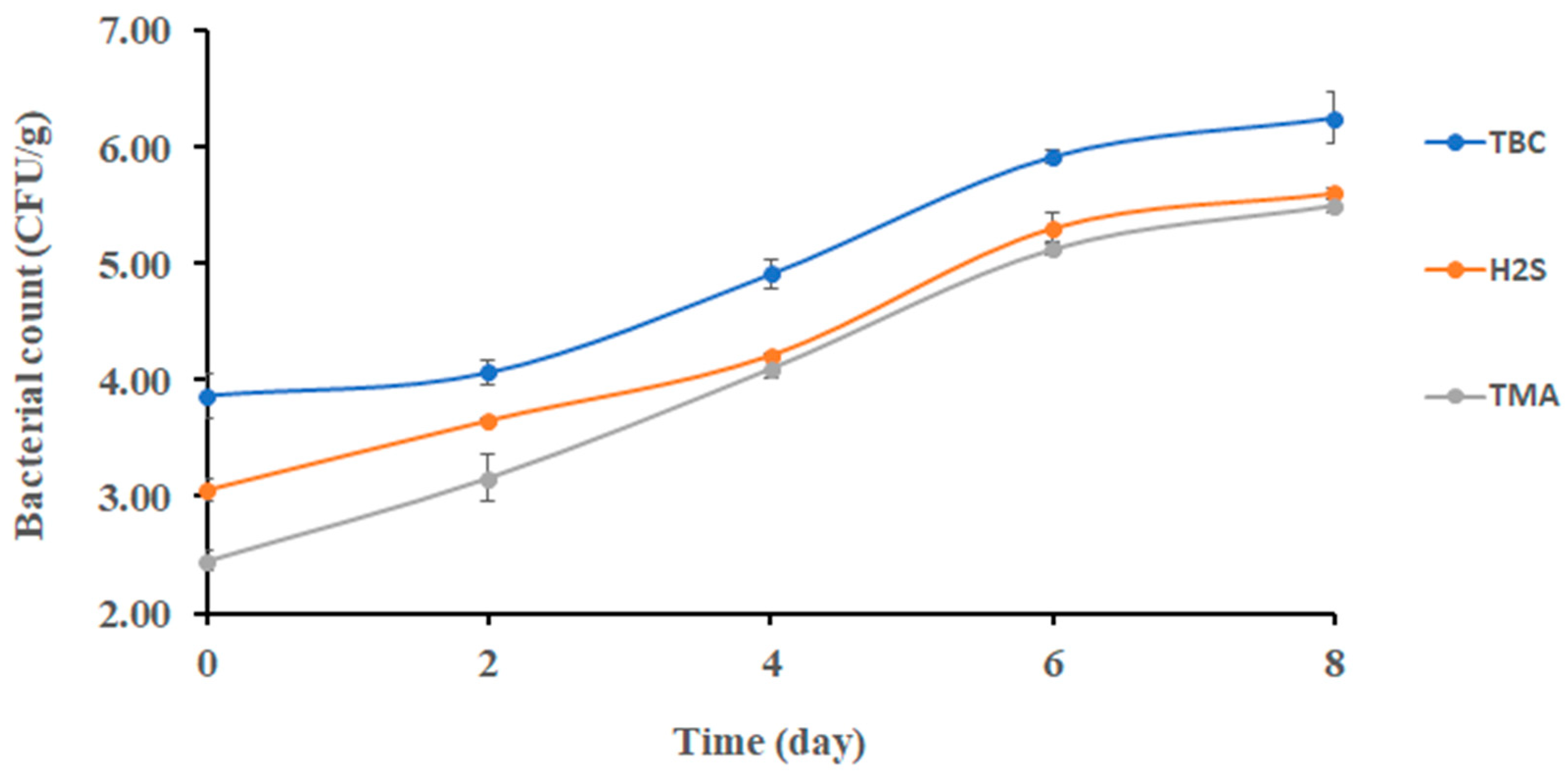
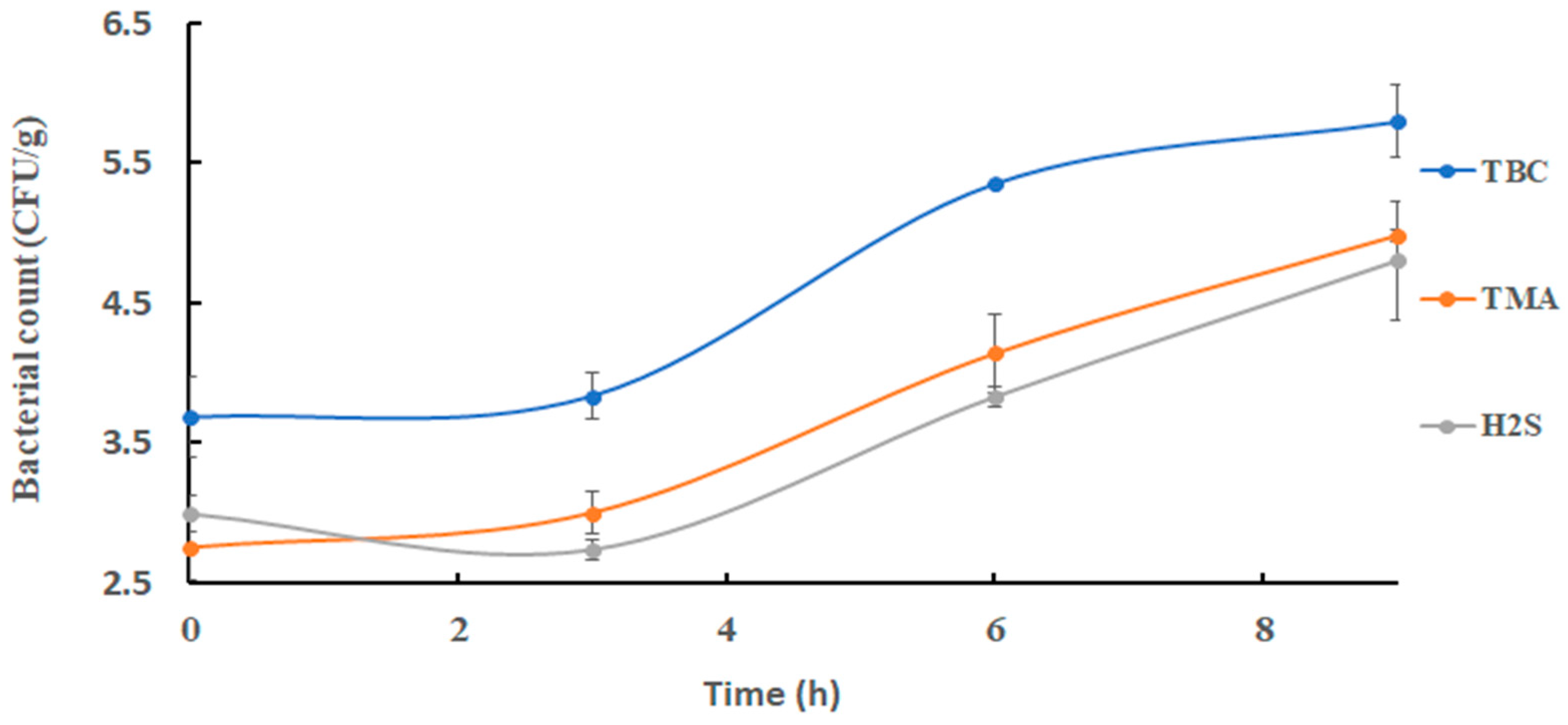

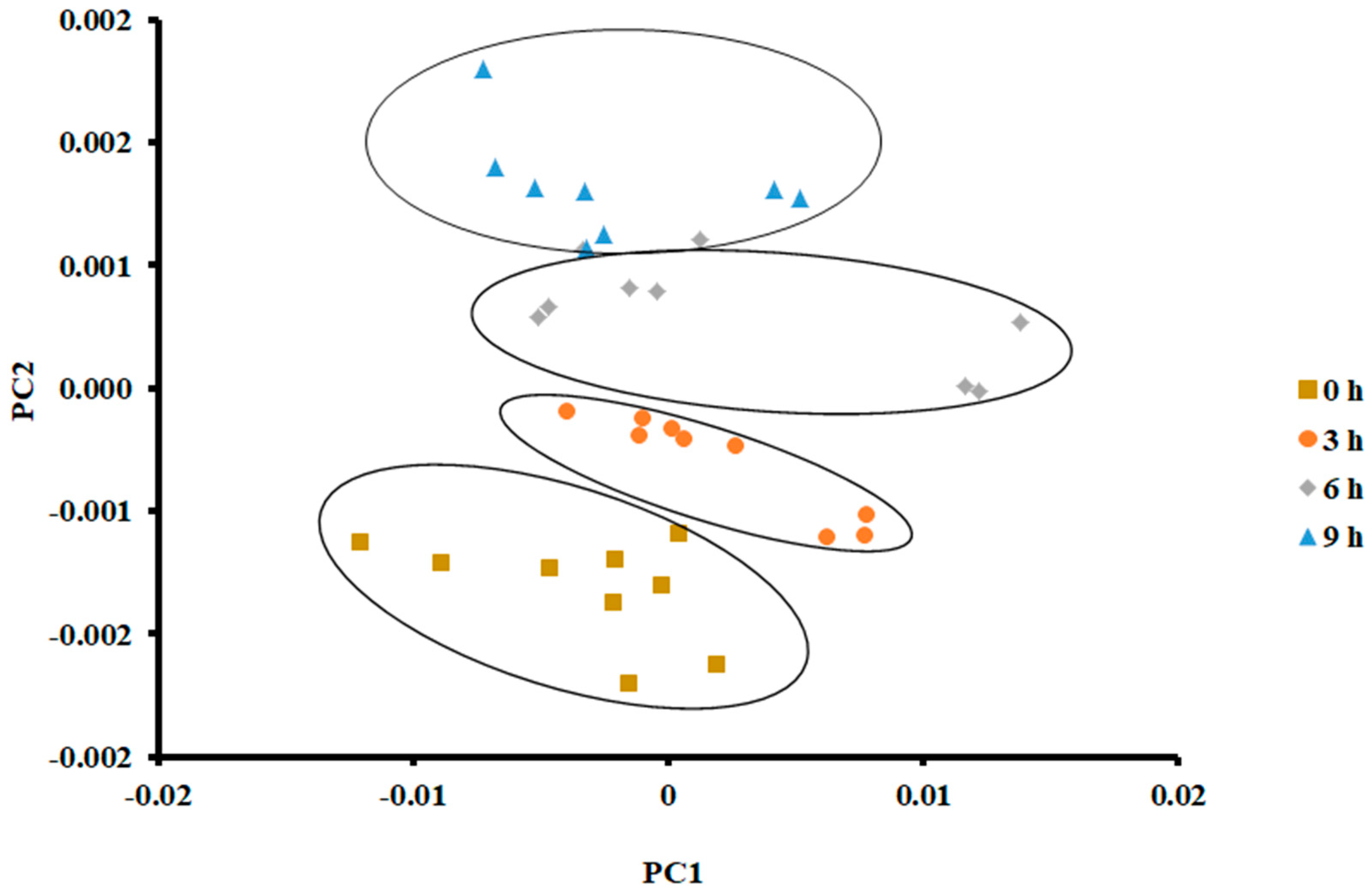

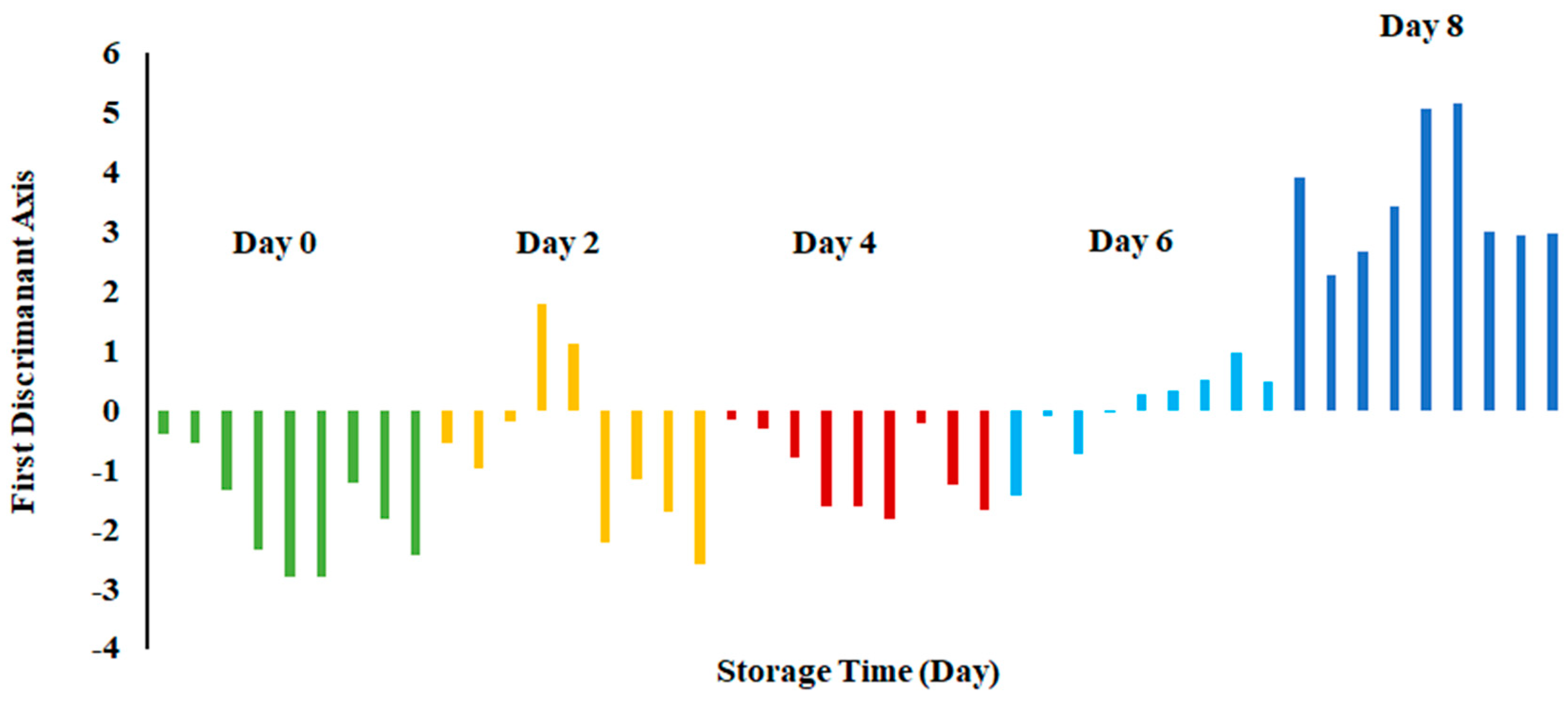
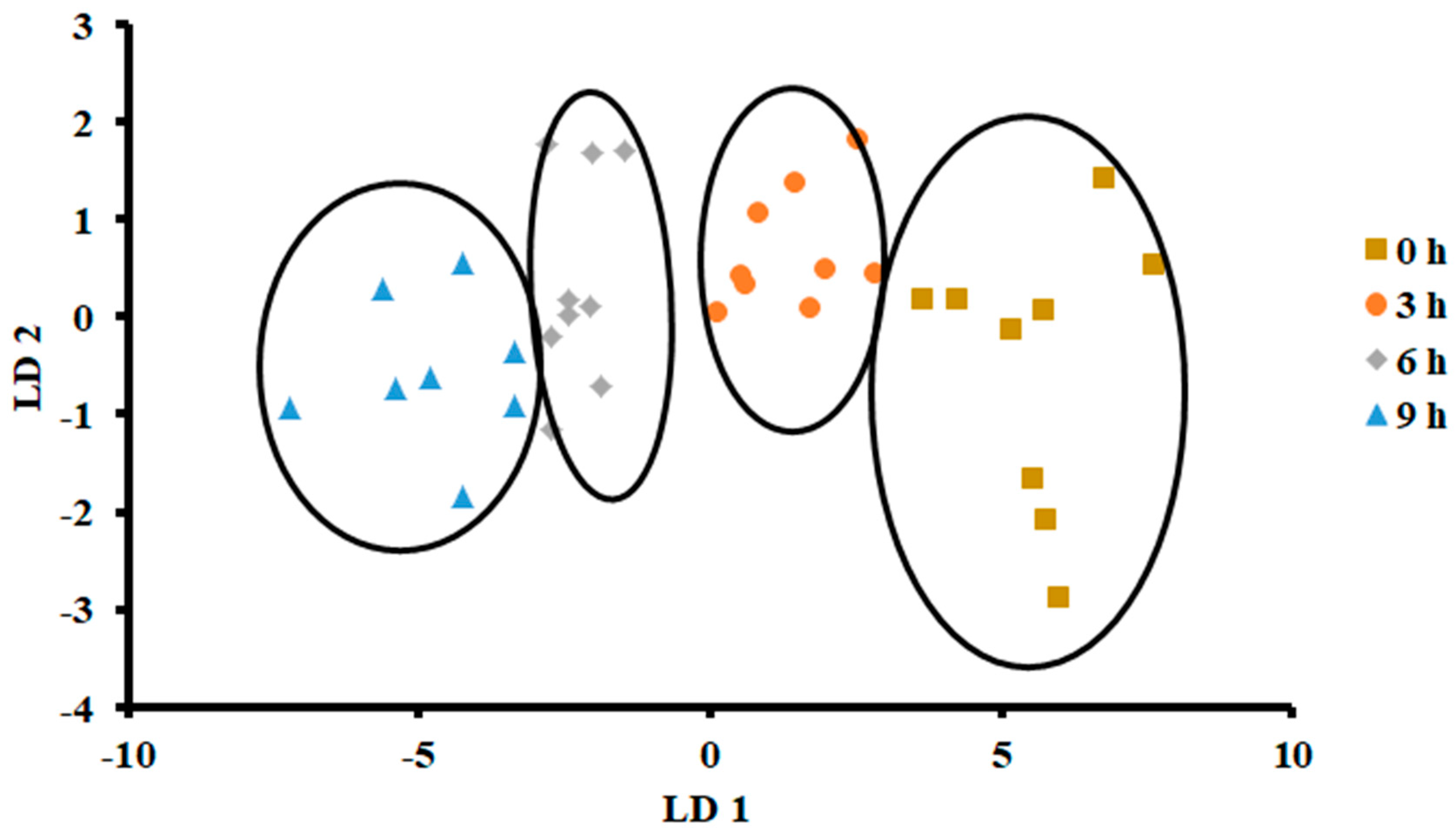

| ** Classified as | a | b | c | d | e |
|---|---|---|---|---|---|
| a | 7 * | 2 | 0 | 0 | 0 |
| b | 3 | 3 * | 2 | 1 | 0 |
| c | 0 | 3 | 3 * | 3 | 0 |
| d | 0 | 0 | 0 | 9 * | 0 |
| e | 0 | 0 | 0 | 0 | 9 * |
| ** Classified as | a | b | c | d |
|---|---|---|---|---|
| a | 9 * | 0 | 0 | 0 |
| b | 0 | 9 * | 0 | 0 |
| c | 0 | 0 | 9 * | 0 |
| d | 0 | 0 | 0 | 9 * |
| Storage Temperature | 0 °C | 25 °C | ||||
|---|---|---|---|---|---|---|
| Performance | TBC * | H2S ** | TMA *** | TBC * | H2S ** | TMA *** |
| R a | 0.919 | 0.915 | 0.960 | 0.859 | 0.945 | 0.849 |
| RMSE b | 0.414 | 0.429 | 0.341 | 0.548 | 0.319 | 0.525 |
Disclaimer/Publisher’s Note: The statements, opinions and data contained in all publications are solely those of the individual author(s) and contributor(s) and not of MDPI and/or the editor(s). MDPI and/or the editor(s) disclaim responsibility for any injury to people or property resulting from any ideas, methods, instructions or products referred to in the content. |
© 2024 by the authors. Licensee MDPI, Basel, Switzerland. This article is an open access article distributed under the terms and conditions of the Creative Commons Attribution (CC BY) license (https://creativecommons.org/licenses/by/4.0/).
Share and Cite
Al-Hooti, H.S.; Al-Bulushi, I.M.; Al-Attabi, Z.H.; Rahman, M.S.; Al-Subhi, L.K.; Al-Habsi, N.A. Efficiency of Electronic Nose in Detecting the Microbial Spoilage of Fresh Sardines (Sardinella longiceps). Foods 2024, 13, 428. https://doi.org/10.3390/foods13030428
Al-Hooti HS, Al-Bulushi IM, Al-Attabi ZH, Rahman MS, Al-Subhi LK, Al-Habsi NA. Efficiency of Electronic Nose in Detecting the Microbial Spoilage of Fresh Sardines (Sardinella longiceps). Foods. 2024; 13(3):428. https://doi.org/10.3390/foods13030428
Chicago/Turabian StyleAl-Hooti, Haitham S., Ismail M. Al-Bulushi, Zahir H. Al-Attabi, Mohammad S. Rahman, Lyutha K. Al-Subhi, and Nasser A. Al-Habsi. 2024. "Efficiency of Electronic Nose in Detecting the Microbial Spoilage of Fresh Sardines (Sardinella longiceps)" Foods 13, no. 3: 428. https://doi.org/10.3390/foods13030428
APA StyleAl-Hooti, H. S., Al-Bulushi, I. M., Al-Attabi, Z. H., Rahman, M. S., Al-Subhi, L. K., & Al-Habsi, N. A. (2024). Efficiency of Electronic Nose in Detecting the Microbial Spoilage of Fresh Sardines (Sardinella longiceps). Foods, 13(3), 428. https://doi.org/10.3390/foods13030428






